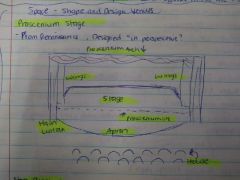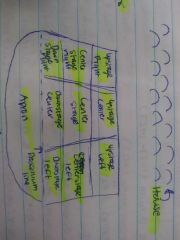![]()
![]()
![]()
Use LEFT and RIGHT arrow keys to navigate between flashcards;
Use UP and DOWN arrow keys to flip the card;
H to show hint;
A reads text to speech;
36 Cards in this Set
- Front
- Back
- 3rd side (hint)
|
Main action |
Main action or larger action of the dance movements |
|
|
|
Initiation |
Which body part leads or initiates the dance movement |
|
|
|
Division of labor |
Way to analyze what part of the body is moving |
|
|
|
Upper-lower |
When movement takes place in your upper or lower body such as arms, chest, torso, legs, feet |
|
|
|
Body half |
When movement is focus on moving either the left or right side of the body |
|
|
|
Core distal |
Movement can begin in the core and work its way out or begin out and work its way back into the core; moving from core to distal parts of the body |
|
|
|
Cross lateral or spiral |
When limbs from opposite sides of the body are moving together i.e. right arm and left leg |
|
|
|
Proscenium stage |

|
|
|
|
Stage directions |

|
From dancers perspective (dancer facing audience) |
|
|
Pathways |
The path a movement can take i.e. curved, angular, simple, complex |
|
|
|
Direction of movement |
The direction a movement can take i.e. forward, backward, diagonal |
|
|
|
Facing |
Where a dancer faces when performing a movement i.e. forward, profile, away |
|
|
|
Level |
Different levels a movement takes place in i.e. high, middle, low |
|
|
|
Locomotion |
Type of movements that move through the space |
|
|
|
Proximity |
If dancers are close together or far apart |
|
|
|
Location |
Where dancers are located on stage i.e. downstage, center stage |
|
|
|
Groupings |
How dancers are grouped i.e solo, duet, trios, quartet, ensembles |
|
|
|
Forms |
How groups are shaped i.e. linear, triangle, circle |
|
|
|
Symmetry vs. Asymmetry |
How similar dancers are performing or grouped vs how unsimilar they are |
|
|
|
Entrances and exits |
How detailed dancers entrances and exits are |
|
|
|
Non-homogenous vs unision |
If dancers move in the space in an ununited manner or united manner |
|
|
|
Thematic |
Dance has a concept, emotion and narrative |
|
|
|
Abstract |
Dance contains movement for movement's sake, visual designs/ patterns, rules-based |
|
|
|
Unision |
Everyone is doing the same thing |
|
|
|
Mirroring |
When dancers mirror each others movements |
|
|
|
Repetition |
Repeating a movement |
|
|
|
Retrograde |
Perform a movement, then do it backwards |
|
|
|
Quality/ energy |
Changing the quality or energy in a movement |
|
|
|
Canon |
Ripple effect |
|
|
|
Accumulation |
Doing small movements then adding to them to make the dance more complicated |
|
|
|
Counterpoint |
Dancers doing different things at the same time |
|
|
|
Contrast |
Differentiation of a movement so it stands out |
|
|
|
ABA |
A dance form that has a cyclical feel, starting from point A then doing B and ending back at point A |
|
|
|
Movement motif |
Movement that expresses the main idea of a dance |
|
|
|
Phrasing |
How you phrase or change a movement to that it is similar but different from the original |
|
|
|
Repetition |
Repeating of movement |
|

